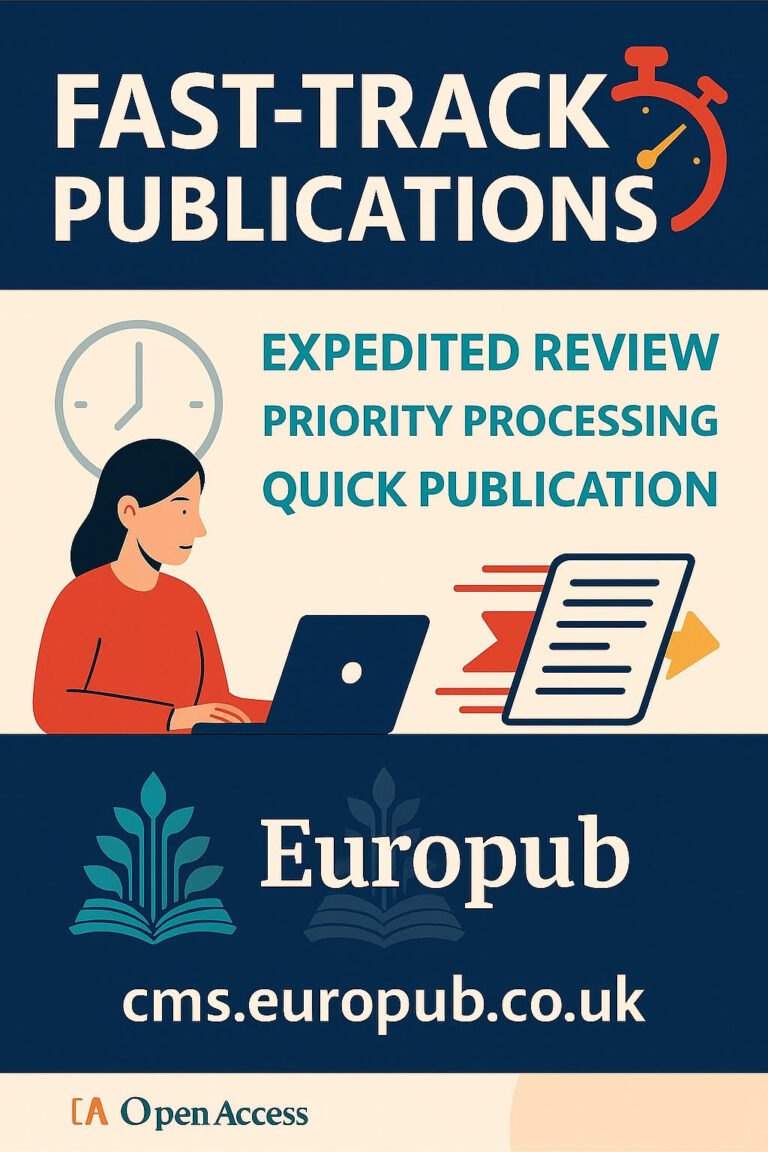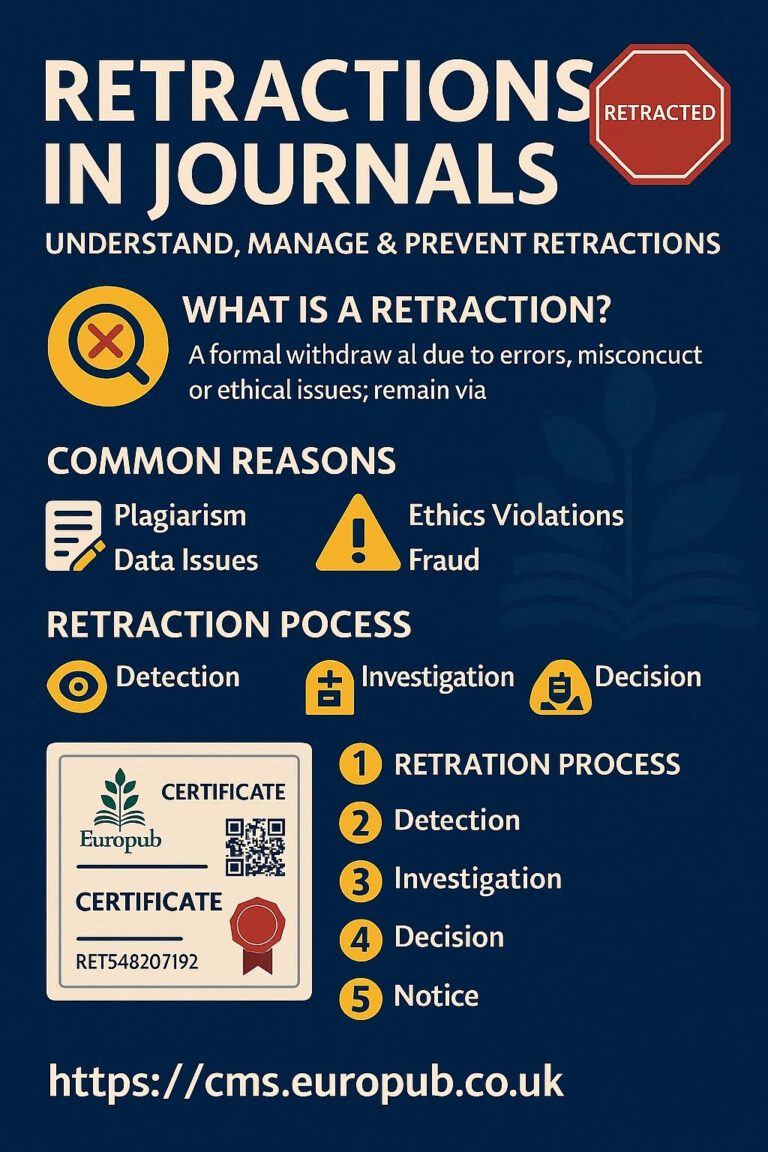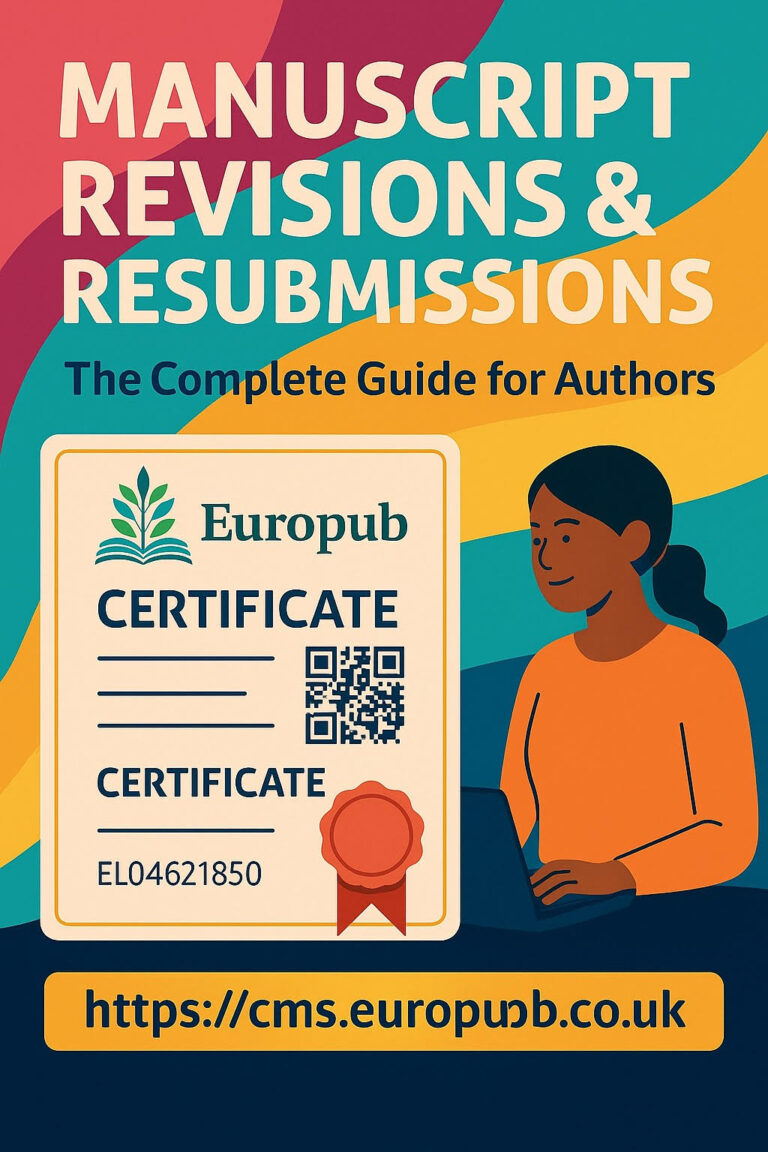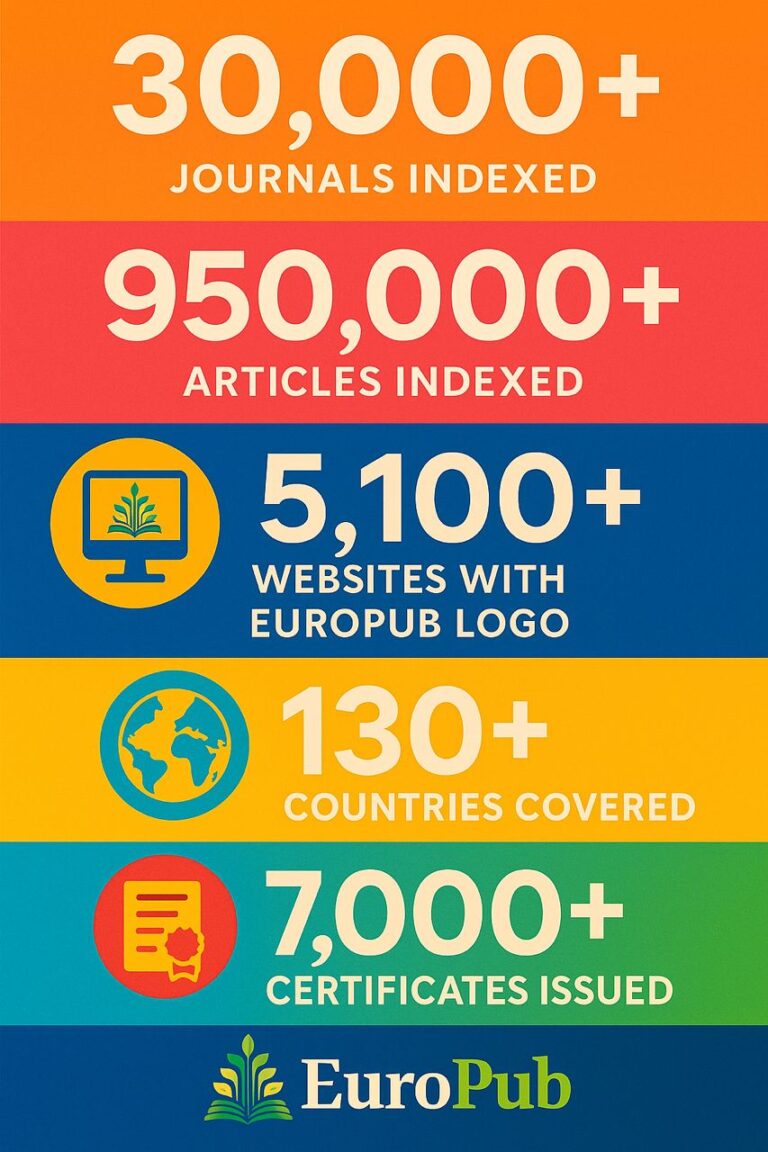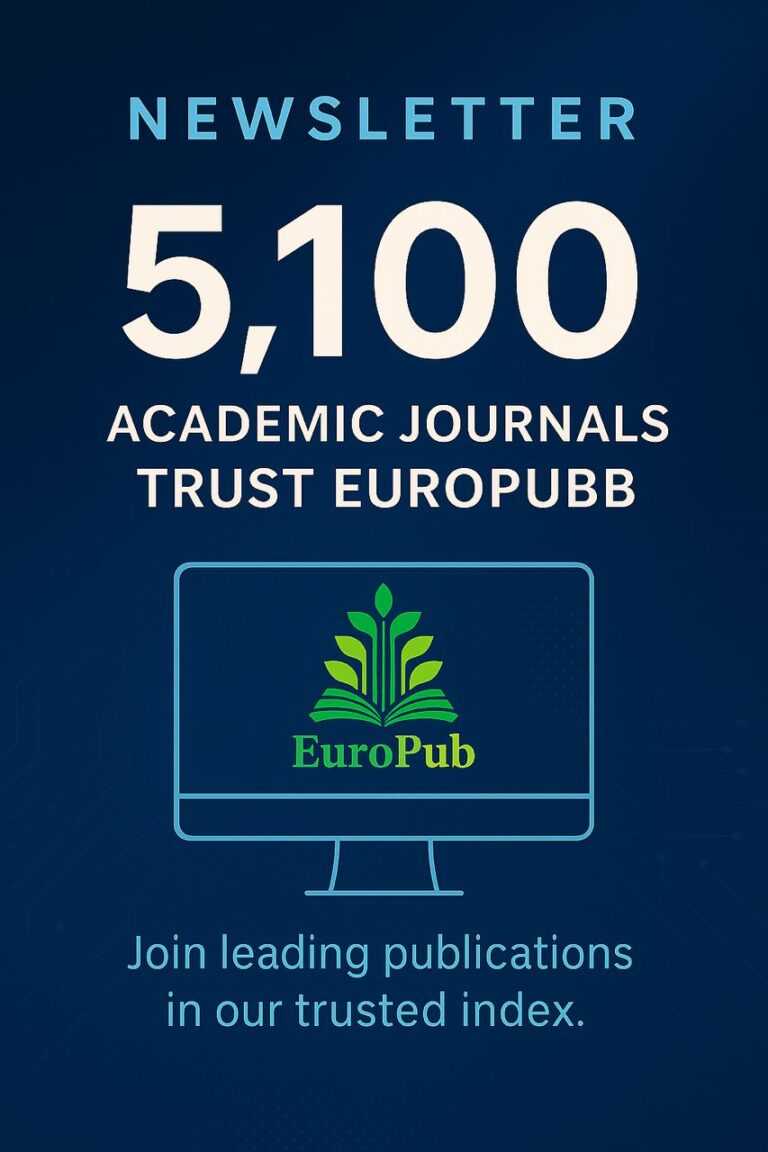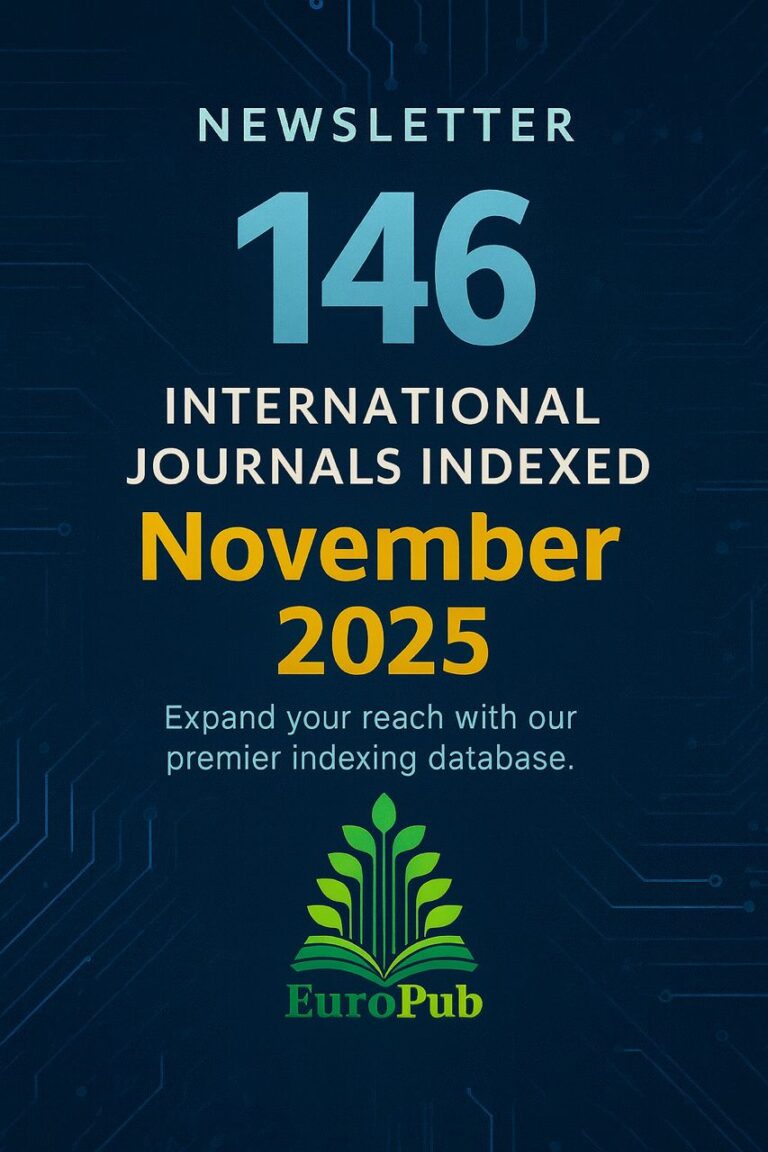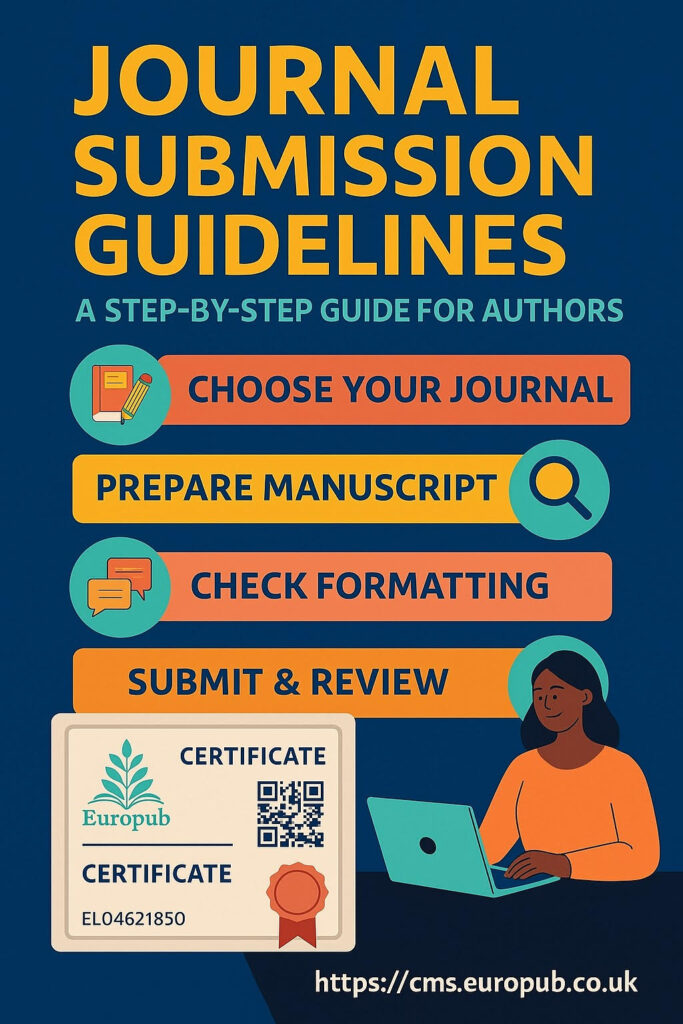
A Complete Step-by-Step Author Guide
(Prepared by Europub Publishing Company Ltd. UK)
 Introduction
Introduction
Submitting a research paper to a journal is a critical step in scholarly publishing.
Proper submission ensures faster review, fewer rejections, and higher visibility.
This guide explains — in detail — every stage of the submission process, from manuscript preparation to post-publication follow-up, in line with Europub, COPE, DOAJ, and ICMJE standards.
 The General Workflow of Submission
The General Workflow of Submission
- Select the Right Journal
- Verify indexing (Scopus, Web of Science, DOAJ, Europub).
- Match aims, scope, and recent issues.
- Prepare the Manuscript
- Follow the journal’s “Instructions for Authors”.
- Include abstract, keywords, introduction, methods, results, discussion, and references.
- Check Formatting Requirements
- Word count, reference style (APA, MLA, Vancouver, Harvard), figure/table formats, line spacing, and margins.
- Perform Technical Checks
- Run a plagiarism scan (Turnitin, iThenticate).
- Verify ORCID for all authors.
- Ensure data and ethics approvals are documented.
- Cover Letter
- Address the Editor-in-Chief directly.
- Summarize novelty, significance, and ethical compliance.
- Online Submission
- Use the journal’s manuscript system or email (if stated).
- Upload files: main text, figures, tables, supplementary data, and cover letter.
- Initial Screening
- Editorial team checks scope, ethics, and completeness.
- Peer Review
- Double-blind or single-blind. Typically 2–3 reviewers.
- Revision and Decision
- “Minor”, “Major”, “Accept”, or “Reject”.
- Provide clear responses in a “Response to Reviewers” file.
- Production and Publication
- Copyediting, typesetting, DOI assignment, and online release.
 Manuscript Components (Checklist)
Manuscript Components (Checklist)
| Section | Description |
|---|---|
| Title Page | Title, authors, affiliations, ORCID, corresponding author info |
| Abstract | 150–300 words summary of aims, methods, results, and conclusions |
| Keywords | 4–6 relevant keywords |
| Introduction | Background, research gap, and objective |
| Materials & Methods | Detailed methodology and reproducibility |
| Results | Tables, figures, and statistical analysis |
| Discussion | Interpretation, implications, and limitations |
| Conclusion | Key takeaways and recommendations |
| Acknowledgements | Funding, assistance, and institutional support |
| References | Properly formatted according to the journal style |
| Ethical Statements | IRB approvals, conflict of interest, informed consent |
| Supplementary Files | Data, figures, code, or appendices |
 Formatting & Technical Guidelines
Formatting & Technical Guidelines
- Font: Times New Roman, 12 pt, double-spaced.
- File Format: .docx or .pdf.
- Figures: High-resolution (300 dpi, .tif or .jpg).
- Tables: Editable, numbered, and titled.
- References: Numbered sequentially or alphabetically (check journal).
- Units: SI units preferred.
- Ethics: Must follow COPE and institutional standards.
 Helpful Tips Before Submission
Helpful Tips Before Submission
- Use plagiarism detectors before submission.
- Verify your reference list accuracy.
- Mention grant numbers and funding agencies.
- Double-check figure numbering.
- Read recent papers in the target journal to align tone and structure.
 Online Submission through Europub
Online Submission through Europub
Authors publishing in journals indexed by Europub can use its integrated submission system:
Features:
 Secure upload portal
Secure upload portal
 Tracking system with secret code
Tracking system with secret code
 QR-based verification
QR-based verification
 Auto-notification for acceptance and certificates
Auto-notification for acceptance and certificates
 Common Mistakes That Delay Publication
Common Mistakes That Delay Publication
- Submitting outside the journal’s scope
- Missing ethics approval or plagiarism report
- Poor English or missing figures/tables
- Ignoring author guidelines
- Incorrect reference formatting
- Submitting to multiple journals simultaneously (unethical)
 After Submission: What Happens Next?
After Submission: What Happens Next?
- Acknowledgment Email → confirms receipt.
- Editorial Screening → 3–7 days average.
- Peer Review → 2–4 weeks.
- Decision Letter → with reviewers’ feedback.
- Revision & Resubmission → upload revised version with detailed responses.
- Final Acceptance & Production → DOI assignment and online publication.
 Certificates & Verification (Europub Feature)
Certificates & Verification (Europub Feature)
Authors, reviewers, and editors can receive digital Europub certificates with QR verification.
- Certificate of Publication
- Certificate of Review
- Certificate of Editorial Contribution
Request here:
 Extended FAQ — 30+ Questions & Answers
Extended FAQ — 30+ Questions & Answers
Q1. How do I know if my paper fits the journal’s scope?
Check the “Aims and Scope” section on the journal’s homepage.
Q2. Should I email the editor before submission?
Optional. A short presubmission inquiry helps clarify suitability.
Q3. What is the average acceptance rate?
Varies from 10%–40% depending on the field.
Q4. How long does peer review take?
Typically 2–6 weeks.
Q5. How do I format references correctly?
Follow the “References” section in the journal’s author guidelines.
Q6. What is a cover letter?
A formal letter introducing your study and its significance.
Q7. Can I submit to multiple journals at once?
No. That’s considered unethical and violates COPE policy.
Q8. How do I declare conflicts of interest?
Include a statement in your manuscript before references.
Q9. What is an ORCID ID and why is it important?
It uniquely identifies researchers. Register at https://orcid.org.
Q10. What are APCs (Article Processing Charges)?
Fees for Open Access publication; check each journal’s page for exact amount.
Q11. Can I request a waiver?
Yes, most journals offer waivers for low-income regions.
Q12. Should figures be embedded or uploaded separately?
Usually both—embedded in text and uploaded as separate files.
Q13. Can I submit in PDF format?
Some journals accept .pdf for initial submission only.
Q14. What is plagiarism tolerance?
Usually below 10–15%, excluding references.
Q15. How can I check plagiarism?
Use Turnitin, iThenticate, or Grammarly Premium.
Q16. Can I use AI writing tools (like ChatGPT)?
Yes, if disclosed and not used to falsify results.
Q17. What is a “blind review”?
Reviewer and/or author identities are hidden.
Q18. How can I track submission progress?
Through the journal’s submission portal or system emails.
Q19. What if my paper is rejected?
Revise according to feedback and submit to another suitable journal.
Q20. Can I resubmit a rejected paper to the same journal?
Yes, only after major revisions and editor permission.
Q21. What if I missed the author guidelines?
You can reformat and resubmit, but this delays processing.
Q22. What is a corresponding author?
The one responsible for communication with the journal.
Q23. Can I add or remove co-authors after submission?
Only with written approval from all authors and the editor.
Q24. What are ethics approval codes?
Institutional Review Board (IRB) or Animal Ethics approvals if applicable.
Q25. How are DOIs assigned?
Through CrossRef upon acceptance.
Q26. Can I suggest reviewers?
Yes, reputable journals allow it.
Q27. How to respond to reviewer comments?
Politely, with numbered responses and evidence of revisions.
Q28. What happens after acceptance?
You receive proofs for correction before online publication.
Q29. How to cite an article before it’s published?
Use “in press” or “accepted for publication”.
Q30. Where can I get a verified publication certificate?
From https://cms.europub.co.uk.
 Trusted References & Links
Trusted References & Links
- https://europub.co.uk — Journal Database
- https://cms.europub.co.uk — Certificate System
- https://news.europub.co.uk — Publishing News
- https://publicationethics.org — COPE Ethics
- https://doaj.org — Open Access Directory
- https://www.scopus.com/sources — Index Verification
- https://mjl.clarivate.com — Web of Science
